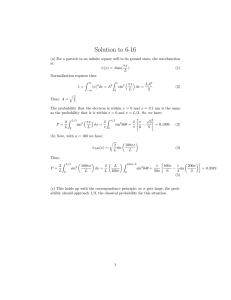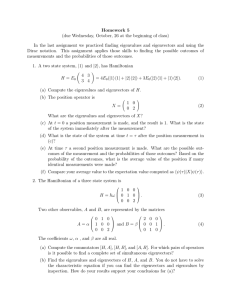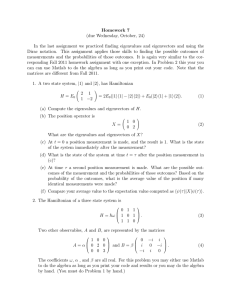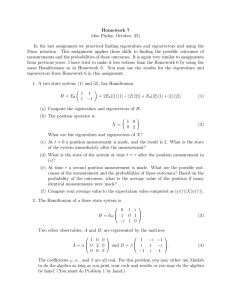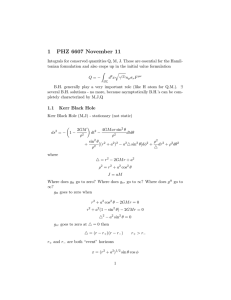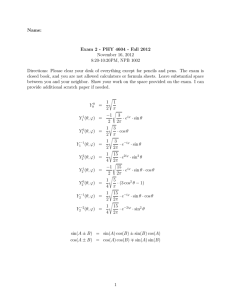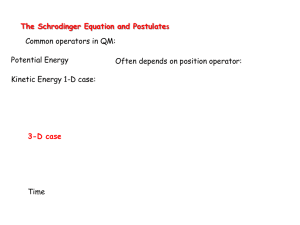Name: Exam 2 - PHY 4604 - Fall 2011 November 16, 2011
advertisement
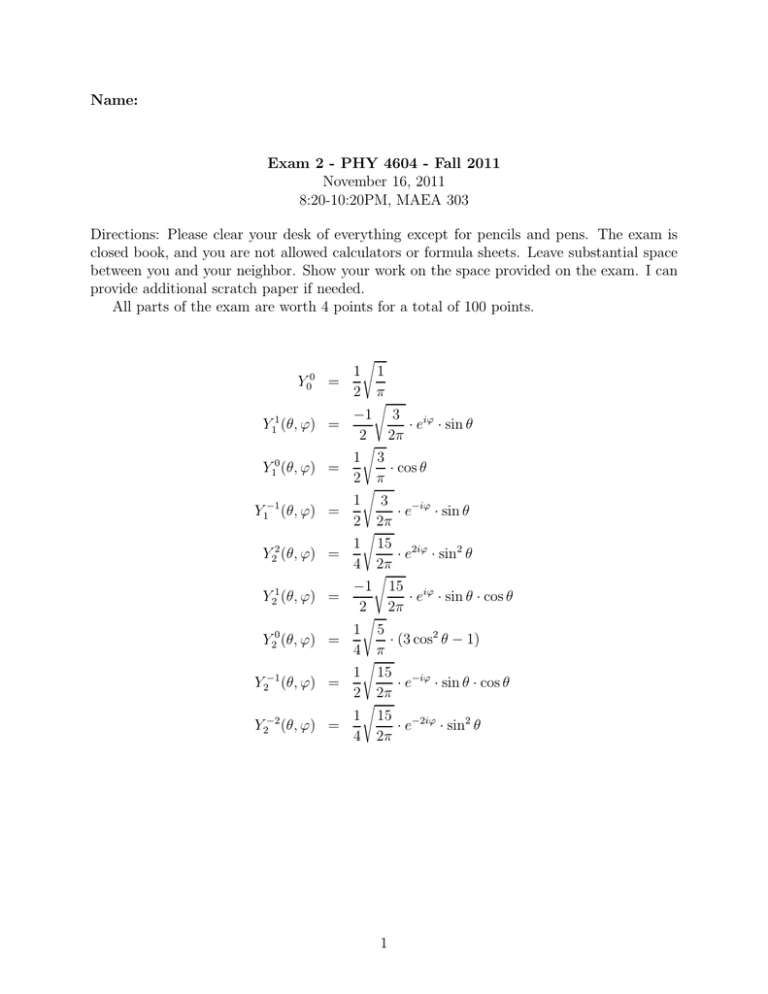
Name: Exam 2 - PHY 4604 - Fall 2011 November 16, 2011 8:20-10:20PM, MAEA 303 Directions: Please clear your desk of everything except for pencils and pens. The exam is closed book, and you are not allowed calculators or formula sheets. Leave substantial space between you and your neighbor. Show your work on the space provided on the exam. I can provide additional scratch paper if needed. All parts of the exam are worth 4 points for a total of 100 points. Y00 1 = 2 s −1 Y11 (θ, ϕ) = 2 1 π s 3 · eiϕ · sin θ 2π 1 = 2 s 3 · cos θ π 1 Y1−1 (θ, ϕ) = 2 s 3 · e−iϕ · sin θ 2π 1 Y22 (θ, ϕ) = 4 s 15 2iϕ · e · sin2 θ 2π Y10 (θ, ϕ) −1 Y21 (θ, ϕ) = 2 s 15 iϕ · e · sin θ · cos θ 2π 1 Y20 (θ, ϕ) = 4 s 5 · (3 cos2 θ − 1) π 1 = 2 s 15 −iϕ ·e · sin θ · cos θ 2π 1 Y2−2 (θ, ϕ) = 4 s 15 −2iϕ ·e · sin2 θ 2π Y2−1 (θ, ϕ) 1 1. Short answer section (a) If hf |g1i = 1 + i and hf |g2i = 1, what is hg1 + g2 |f i? (b) What is the completeness condition for a set of states |ψn i? (c) What is (xp)† ? Is the operator (xp) Hermitian? (d) How many m values are there for j = 5/2? (e) What is the energy in eV of the second excited state (n = 3) for the hydrogen atom? 2 2. Eigenvectors and eigenvalues The Hamiltonian of a two state system is represented by the matrix √ ! 2√ i 5 H = h̄ω . −i 5 −2 (a) What are the energy eigenvalues? (b) What are the normalized energy eigenvectors? 3 (c) At t = 0 the system is in state 1 √ 2 1 i ! . What is the expectation value of the energy at t = 0? (d) What is the expectation value of the energy at time t > 0? (e) What is the state of the system at time t > 0? 4 3. Measurements Three Hermitian operators have eigenvalues, λ and eigenvectors given below ! 1 1 1 σx operator : λ = 1 with √ and λ = −1 with √ 2 1 2 ! 1 1 1 and λ = −1 with √ σy operator : λ = 1 with √ 2 i 2 ! ! 1 0 σz operator : λ = 1 with and λ = −1 with 0 1 1 −1 1 −i ! ! (a) At t = 0, the state of the system is given by 3/5 4i/5 ! . If a σy measurement is made at t = 0, what are the possible outcomes and their associated probabilities? (b) In all of the following, assume that σy was found to be +1. What is the state of the system immediately after the measurement? 5 (c) The hamiltonian of the system is given by H = h̄ωσz . Using the result of the measurement at t = 0 in part (b), what is the state of the system at time t > 0? (d) A measurement of σx is next made at time t > 0. What are the possible outcomes and associated probabilities? (e) In the answer for part (d) are there any times, t, for which the outcome is known with 100% certainty? If so, how can one explain 100% certainty in quantum mechanics? 6 4. Angular Momentum (a) Compute the commutator [Lx , Ly Lz ] . (b) Compute the matrix element h2, 1|Lx |2, 0i. (c) Compute the matrix element h2, 0|L2x |2, 0i. 7 (d) An L2 measurement is performed on a wavefunction ψ(r, θ, φ) = f (r) sin2 (θ). What are the possible outcomes? (e) An Lz measurement is performed on a wavefunction ψ(r, θ, φ) = f (r) sin2 (θ). What are the possible outcomes? 8 5. Radial Schrodinger Equation In this problem use the potential in spherical coordinates V (r) = ∞ for r < a V (r) = −V0 for a < r < b V (r) = 0 for b < r. with V0 > 0. We are going to look for the bound states for −V0 < E < 0. (a) Solve the l = 0 radial Schrodinger equation for u in the region a < r < b. Given that u(a) = 0 because the potential is infinity for r < a, what is the general form of the solution in this region? (b) Solve the l = 0 radial Schrodinger equation for u in the region r > b. Given that we want the wave function to be normalizable, what is the general form of the solution in this region? 9 (c) Match the boundary conditions at r = b and derive a equation for the bound states. (d) Derive the condition on V0 for there will not be a l = 0 solution (bound state) for −V0 < E < 0. (e) Derive the condition on V0 for there to be only one l = 0 solution (bound state) for −V0 < E < 0. 10
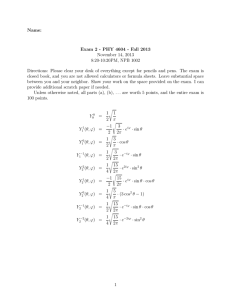
![8LMW MW E FSRYW QIERMRK STXMSREP LSQI[SVO -X [MPP LIPT... XLI RI\X I\EQ ERH MW HYI SR ;IHRIWHE] 2SZIQFIV](http://s2.studylib.net/store/data/010390149_1-6ffd3fa43342fe38ebf2b11f5734ca49-300x300.png)
